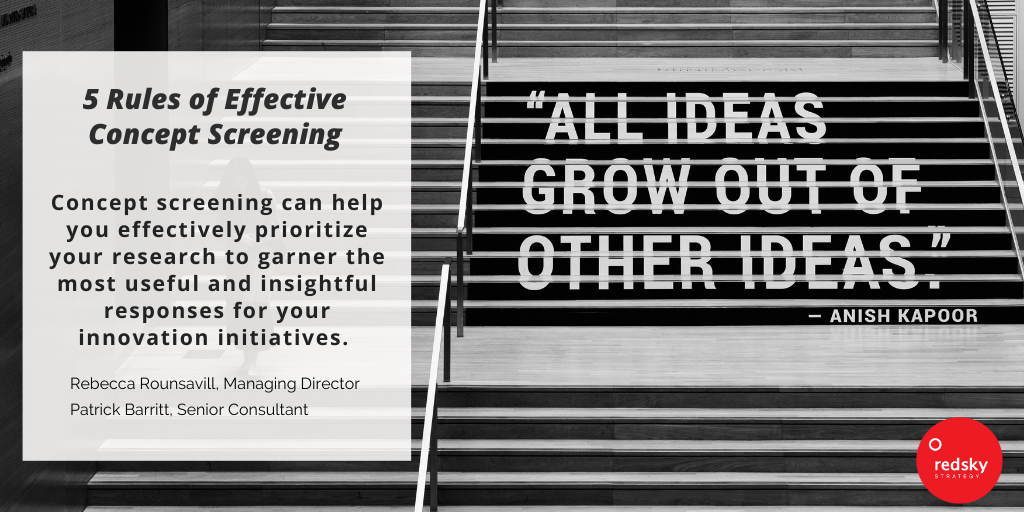News
5 Rules of Effective Concept Screening

Image Credit: https://unsplash.com/photos/xX2aYSBsyKo
Do you ever get more many good ideas than you could ever effectively launch? That is exactly what you will encounter with a well-run innovation process. While some companies will cherry pick their favorites based on personal preferences, the better option is to utilize your target to prioritize. This is where “Concept Screening” research comes into play.
“Concept Screening” is the process by which brands garner consumer insight to help prioritize and refine the available options. This is usually done quantitatively by presenting ideas and analyzing the responses, often using standardized questions such as likelihood to purchase. But many times, the results will be unclear, and it is difficult for marketing teams to make product pipeline decisions.
Here are a few rules to help ensure you get an actionable result from your research:
1. Test Complete Concepts
This may seem obvious, but we encounter many companies who only test idea statements for cost savings. This method tends to favor “me-too” ideas that require less explanation. For consumers to truly visualize a new product, they require in-depth concepts that accurately describe the need addressed, the product itself, its components and how it benefits them—preferably with a picture. If you genuinely do not have enough money for a full concept test, don’t do it at all. An internal survey will be just as effective.
2. Be Mindful of Respondent Fatigue
Research can be easy to do, but it can be easier to do wrong. Remember: the participants taking your survey are people, and people have limited attention spans. So try to limit the length of the survey. Also, be sure to vary the kinds of questions asked for each concept to keep people stimulated and engaged. Rotating concept order will enable each concept to get the full range of analytics. In a recent study conducted by RedSky Strategy, we presented 5 innovation concepts to respondents. The first concept viewed scored an average 8 percentage points higher in purchase interest than the fifth. We noted where the drop-off occurred and excluded responses by fatigued respondents.
3. Decision Criteria Should Go Beyond Purchase Interest
At the beginning of your analysis, you should decide on the key variables upon which to base your decision for prioritization. While purchase intent will clearly factor into most decision making, a successful launch often requires more. For crowded categories, uniqueness may play just as important a role as purchase interest. Expensive categories might require value or “worth the money”, and brand fit might be key for brands seeking to expand into new areas. If you are a category leader, you may want to utilize a turf analysis to look at incrementality. Lastly, use your heart. Sometimes, the most innovative and exciting products score lower because consumers don’t quite understand the products or how they will fit into their lives. It may require a few rounds of research to get it right — if it is exciting, stick with it and work on the idea until it becomes a true winner.
4. Optimize the Idea Through Diagnostics
Ensure you are asking the right range of questions to help improve your proposition. We often refer to our range of questions as LURVE (Likability, Uniqueness, Relevance, Value, Estimated Frequency). Do they really LURVE it? Another tool is the highlighter tasks where respondents select the words that stand out to them most to help marketers zero in on the most resonant words or phrases. Open-ended questions (either text based or video testimonials) are critical to understanding quantitative results and driving interest internally. We have used video feedback from concept tests in sales presentations, adding to the excitement of the launch.
5. Tell Stories that Go Deeper than Data
When doing any kind of market research analysis, it’s very easy to focus on the “research” and forget about the “market” part of it. Remember: context is key when making strategic decisions. So putting your findings into context with greater market understanding will enrich the analysis and insight you can provide your clients. In addition, asking deeper open-ended questions can potentially yield deeper insights. For a pet product, we once asked consumers to respond from their pet’s perspective using their voice. It helped the team get a much richer understanding of the higher order benefit to the pet owner.
All in all, Concept Screening is important as it ultimately determines a brand’s innovation strategy and should be taken on with as much care and consideration as the innovation process itself. At RedSky Strategy, we help brands harness and leverage innovation as a launching pad for their growth. Through HumanSight, we can help you effectively connect to your audience and better understand their needs so that you can both respond and evolve accordingly.
Are you interested in working with RedSky Strategy? We look forward to hearing from you to learn how we can help you strategically garner consumer insights and develop a deeper understanding of your market and target audience.
